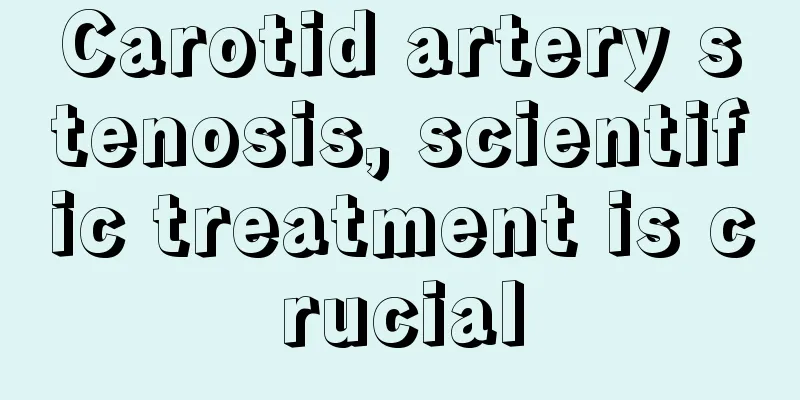Carotid artery stenosis, scientific treatment is crucial

|
Carotid artery stenosis is a very common disease in daily life, but people know very little about it. In fact, the carotid artery is divided into four levels: mild, moderate, severe and carotid artery occlusion. Patients need to receive scientific treatment methods based on their own examination results in order to recover their health as soon as possible. 1. Causes of Carotid Artery Stenosis Atherosclerosis is the main cause of carotid artery stenosis. Generally speaking, high blood pressure, diabetes, hyperlipidemia, coupled with some people's bad habits such as smoking, alcoholism, etc., may accelerate the occurrence of atherosclerosis. Specifically, lipids in the blood accumulate on the inner wall of the carotid artery. Over time, this causes the carotid intima to proliferate and deteriorate, leading to ulcers, calcification, and even plaque formation, which blocks the carotid artery and causes narrowing of the carotid lumen. 2. Symptoms of Carotid Artery Stenosis The stenosis of the carotid artery and the reduction of the lumen will inevitably lead to a decrease in blood flow and cause some ischemic symptoms in the brain. There may be tinnitus, blurred vision, dizziness, headache, memory loss, drowsiness or insomnia, and nightmares. There may also be transient ischemic attacks such as vertigo and black membranes. In severe cases, there may be paroxysmal syncope and even hemiplegia, aphasia, and coma. A small number of patients have decreased vision, hemianopsia, diplopia, and even sudden blindness. Carotid artery stenosis may cause ischemic manifestations of the eye, such as corneal leukoplakia, cataracts, iris atrophy, retinal atrophy or pigmentation, optic disc atrophy, venous hemorrhage, etc. In addition, if the carotid artery plaque or blood clot breaks off, it may lead to acute cerebral infarction, which is very scary. 3. Grading of Carotid Artery Stenosis Carotid artery stenosis is graded into different degrees according to the stenosis rate. A stenosis rate of 0-50% is mild stenosis, a stenosis rate of 50%-70% is moderate stenosis, a stenosis rate above 70% is severe stenosis, and if the stenosis rate reaches 100%, it means the carotid artery is occluded. Treatment of Carotid Artery Stenosis The treatment method varies according to the degree of carotid artery stenosis. The treatment of carotid artery stenosis generally includes conservative medical treatment and surgical treatment. Generally, mild stenosis is treated with conservative medical treatment, taking antiplatelet aggregation drugs or statins to control and slow down carotid artery plaques, and controlling blood pressure, blood sugar, blood lipids, etc., and eliminating adverse factors such as smoking and alcoholism. If the carotid artery stenosis reaches moderate to severe levels, surgical treatment should be considered. Depending on the patient's specific situation, carotid artery stenting or carotid endarterectomy can be selected. If the carotid artery is occluded, vascular bypass surgery is the only option. Carotid endarterectomy is a standard surgery for treating carotid artery stenosis and preventing cerebral infarction. At present, some hospitals in China that are relatively mature in performing this surgery include the Air Force General Hospital of China Medical University. Professor Jin Yongjian, director of the hospital's cerebrovascular neurosurgery department, is a medical doctor who studied in Japan and has high attainments in the surgical treatment of cerebrovascular diseases, especially endarterectomy for carotid artery stenosis. The carotid endarterectomy he introduced was a surgery that removed carotid artery plaques, completely eliminated the root cause of stenosis, restored the size of the carotid artery lumen, and thus restored blood supply. Professor Jin Yongjian has completed more than one thousand carotid endarterectomies, all of which achieved good treatment results. |
<<: How to relieve hand and arm pain?
>>: How to relieve depression?
Recommend
Dangers of blood donation between close relatives and couples
Science Q&A We know that when performing orga...
How to treat lumbar disc herniation and bulging?
Lumbar disc disease is a relatively common diseas...
5 daily factors that lead to cervical cancer What are the nutritional recipes to prevent cervical cancer
Recently, GlaxoSmithKline's cervical cancer v...
Putty powder formula and ingredients
House prices and commodity prices have begun to s...
Skin becomes red and swollen after being bitten by a mosquito
Mosquitoes are very annoying little insects. The ...
How to clean glasses cloth
I wonder if friends who wear glasses have the hab...
What are the causes of osteoporosis in young people
With the changes in life, more and more diseases ...
What are the early symptoms of cervical cancer
The early symptoms of cervical cancer include abn...
What are the benefits of cupping and scraping
Cupping and scraping have a very long history in ...
Plants suitable for bedrooms
The bedroom is a very private place for people. I...
Will the placenta grow back and come down?
The placenta begins to develop gradually after th...
What are the effects of vinegar and rock sugar
Vinegar and rock sugar are especially suitable fo...
What are the symptoms of advanced lung cancer? Introduction to the symptoms of advanced lung cancer
The existence and growth of lung cancer will inev...
What to do if you can't sleep in a different place
Insomnia is a common problem when people sleep, e...
Soak your feet after running
Running can exercise the muscles of our feet and ...









